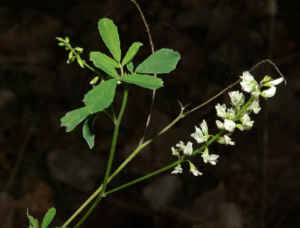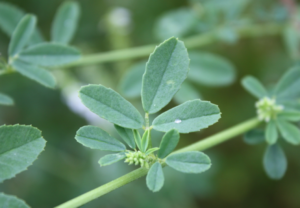Common Name: White Sweet Clover
Specific Name: Melilotus alba
Known Occurrence at Taylor Point:
Map Areas: Beach 1C
Category: Non-Native, Herbaceous Plant

Ecological Considerations:
Melilotus alba, commonly known as White Sweet Clover is native to Europe and Asia. In the 1600s it was introduced to North America and used for cattle forage. Now widespread throughout Canada and the United States, it has become invasive and can outcompete native plant species. It thrives in disturbed areas and often is found along roadsides. It can grow in full-sun or partial-shade, but is shade-intolerant.
White Sweet Clover can grow up to 5 feet high. It is biennial or annual and is monocarpic (that is it dies after it flowers and sets seed) and it is able to self-pollinate. The first year, White Sweet Clover will grow a primary stem up to 3 to 5 feet tall, and will put down a deep taproot. In favorable conditions it may flower and set seed in its first year, but more often the seeds are set in the second year.
The root crown of White Sweet Clover ordinarily produces between 1 and 10 smooth, hairless, erect, and branched, grooved or channeled stems. Its leaves have 3 leaflets, and are alternate along the stem. Each leaflet is fully toothed and may be hairy but are usually smooth.
White Sweet Clover flowers appear from June to October in multiple racemes (clusters which are separate from the stem). The stalks of white flowers each have between 20 and 65 flowers. While White Sweet Clover can self-pollinate, its flower structure encourages cross pollination by insects, primarily honey bees and bumble bees.
The seed pods are dark gray or black. Each pod contains a single yellow oval seed. One plant can produce up to 350,000 seeds. Seeds often remain on the plant over the winter and fall as they dry out.
A legume, White Sweet Clover is favored for its nitrogen-fixing ability. Its flowers are attractive to bees and butterflies and in some areas it is a popular plant for honey production. Deer and rabbits are known to feed on White Sweet Clover and birds feed on the plant’s seeds.
White Sweet Clover can be somewhat toxic to humans. The smell of freshly-cut plants can cause headaches and nausea in some people. Its characteristic sweet odour, intensified by drying, is derived from coumarin, an anticoagulant.
Problems Posed by this Plant: White Sweet Clover often outcompetes native species, growing quickly and growing tall, depriving other species of sunlight. It also is allelopathic, meaning the roots release chemicals into the soil which can prevent the growth of native plants.
Native Species Affected by this Plant:
Propagation Mechanisms and Related Issues Affecting Efforts to Remove this Plant from Taylor Point:
Documented Best Removal Practices and Options/Pros and Cons of Various Options:
Control measures for White Sweet Clover are most successful when heavily infested sites are re-planted with native species that are able to out-compete new growth. White Sweet Clover thrives on disturbance (like that caused by control measures), and will likely re-invade or re-sprout if restoration measures are not taken.
Case Studies of Removal Efforts, Lessons Learned and Recommendations:
Additional Photos:


Sources cited:
Go Botany
Ontario Invasive Plants
Wiki White Sweet Clover
USDA
Key Words:
Melilotus alba
While Sweet Clover
